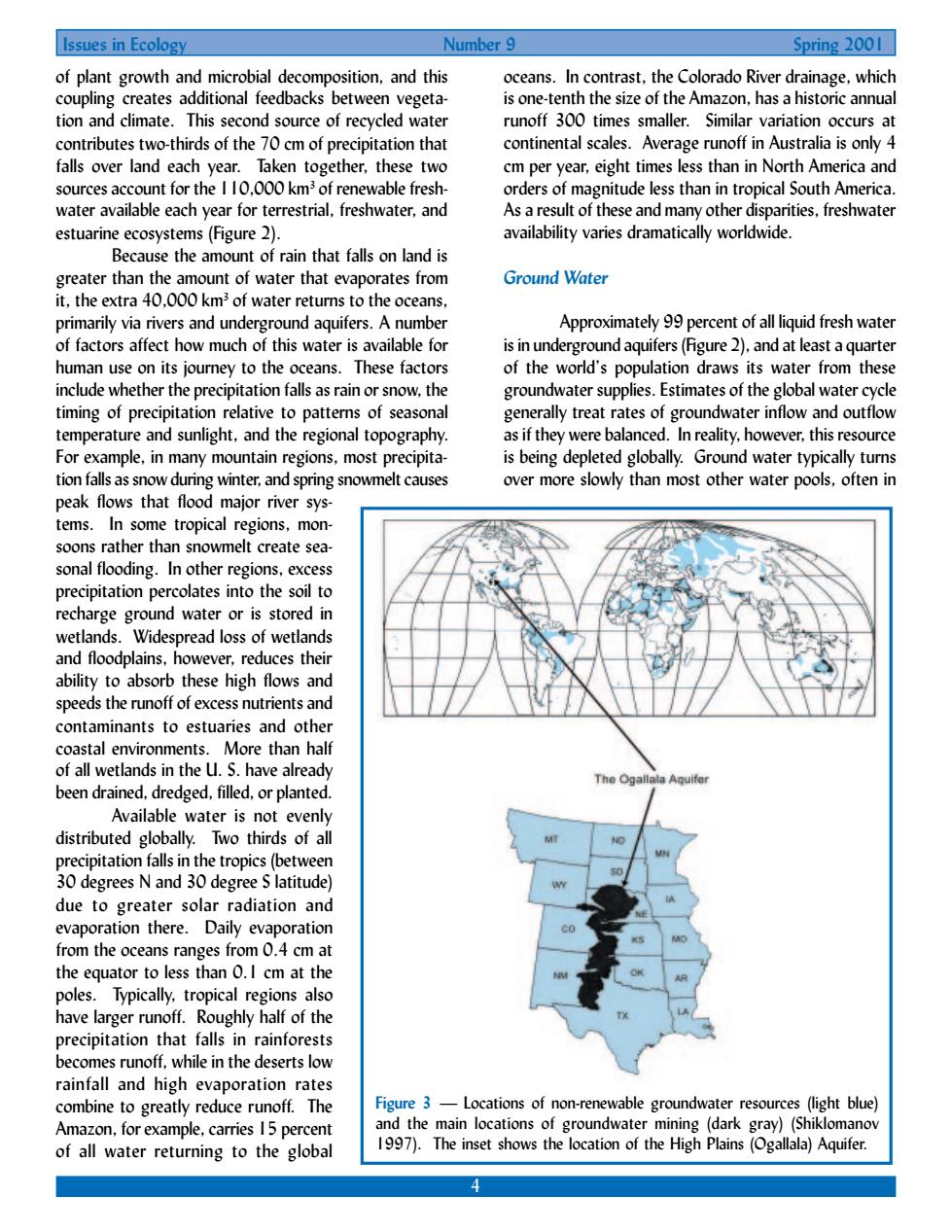正在加载图片...

Issues in Ecology Spring 2001 of plant growth and microbial decc adtiomalecback osition,and this betwee anssthe Colorado iverr nth the size he Ar times smaller. Simila variati occurs contributes two-thirds of the 70 cm of precipitation that continental scales.Average runoff in Australia is only 4 falls over land each year.Taken together,these two cm per year,eight times less than in North America and sources account for the I 10.000 km3 of renewable fresh- orders of magnitude less than in tropical South America water available each year for terrestrial,freshwater,and As a result of these and many other disparities.freshwater estua availability varies dramatically worldwide. greater than the amount of water that evaporates from Ground Water it,the extra 40,000 km of water returns to the oceans. primarily via rivers and underground aquifers.A number Approximately 99 percent of all liquid fresh water of factors affect how much of this water is available for is in underground aquifers(Hgure 2).and at least a quarter human use on its journey to the oceans.These factors of the world's population draws its water from these include whethe the pitation falls as rair lies.Estimates of the global wate timing of precipitati relative 8代 erally trea dwate temperature and sunlight,and the regional topography as if they were balanced.In reality.however,this resource For example,in many mountain regions,most precipita is being depleted globally.Ground water typically turns tion falls as snow during winter,and spring snowmelt causes over more slowly than most other water pools.often in peak flows that flood major river sys. tems.In some tropical regions,mon- soons rather than s owmelt create s sona flo In othe pre cipitation thes to recharge ground water or is stored in wetlands.Widespread loss of wetlands and floodplains.however.reduces their ability to absorb these high flows and speeds the runoff of excess nutrie nts and con aminan ts to estua s and othe coastal e onments ore than halt of all wetlands in the U.S have already been drained,dredged,filled,or planted. Available water is not evenly distributed globally Two thirds of all pitation falls in the t latituo due to greater sola radiation and evaporation there.Daily evaporation from the oceans ranges from 0.4 cm at the equator to less than O.I cm at the poles.Typically,tropical regions also have larg noff.Roughly half of the that falls rainforests in thedeser rainfall and high evaporation rates combine to greatly reduce runoff.The Figure 3-Locations of non-renewable groundw Amazon,for example.carries 15 percent of all water returning to the global 1997.4 Issues in Ecology Number 9 Spring 2001 of plant growth and microbial decomposition, and this coupling creates additional feedbacks between vegetation and climate. This second source of recycled water contributes two-thirds of the 70 cm of precipitation that falls over land each year. Taken together, these two sources account for the 110,000 km3 of renewable freshwater available each year for terrestrial, freshwater, and estuarine ecosystems (Figure 2). Because the amount of rain that falls on land is greater than the amount of water that evaporates from it, the extra 40,000 km3 of water returns to the oceans, primarily via rivers and underground aquifers. A number of factors affect how much of this water is available for human use on its journey to the oceans. These factors include whether the precipitation falls as rain or snow, the timing of precipitation relative to patterns of seasonal temperature and sunlight, and the regional topography. For example, in many mountain regions, most precipitation falls as snow during winter, and spring snowmelt causes peak flows that flood major river systems. In some tropical regions, monsoons rather than snowmelt create seasonal flooding. In other regions, excess precipitation percolates into the soil to recharge ground water or is stored in wetlands. Widespread loss of wetlands and floodplains, however, reduces their ability to absorb these high flows and speeds the runoff of excess nutrients and contaminants to estuaries and other coastal environments. More than half of all wetlands in the U. S. have already been drained, dredged, filled, or planted. Available water is not evenly distributed globally. Two thirds of all precipitation falls in the tropics (between 30 degrees N and 30 degree S latitude) due to greater solar radiation and evaporation there. Daily evaporation from the oceans ranges from 0.4 cm at the equator to less than 0.1 cm at the poles. Typically, tropical regions also have larger runoff. Roughly half of the precipitation that falls in rainforests becomes runoff, while in the deserts low rainfall and high evaporation rates combine to greatly reduce runoff. The Amazon, for example, carries 15 percent of all water returning to the global oceans. In contrast, the Colorado River drainage, which is one-tenth the size of the Amazon, has a historic annual runoff 300 times smaller. Similar variation occurs at continental scales. Average runoff in Australia is only 4 cm per year, eight times less than in North America and orders of magnitude less than in tropical South America. As a result of these and many other disparities, freshwater availability varies dramatically worldwide. Ground Water Approximately 99 percent of all liquid fresh water is in underground aquifers (Figure 2), and at least a quarter of the worlds population draws its water from these groundwater supplies. Estimates of the global water cycle generally treat rates of groundwater inflow and outflow as if they were balanced. In reality, however, this resource is being depleted globally. Ground water typically turns over more slowly than most other water pools, often in Figure 3 — Locations of non-renewable groundwater resources (light blue) and the main locations of groundwater mining (dark gray) (Shiklomanov 1997). The inset shows the location of the High Plains (Ogallala) Aquifer